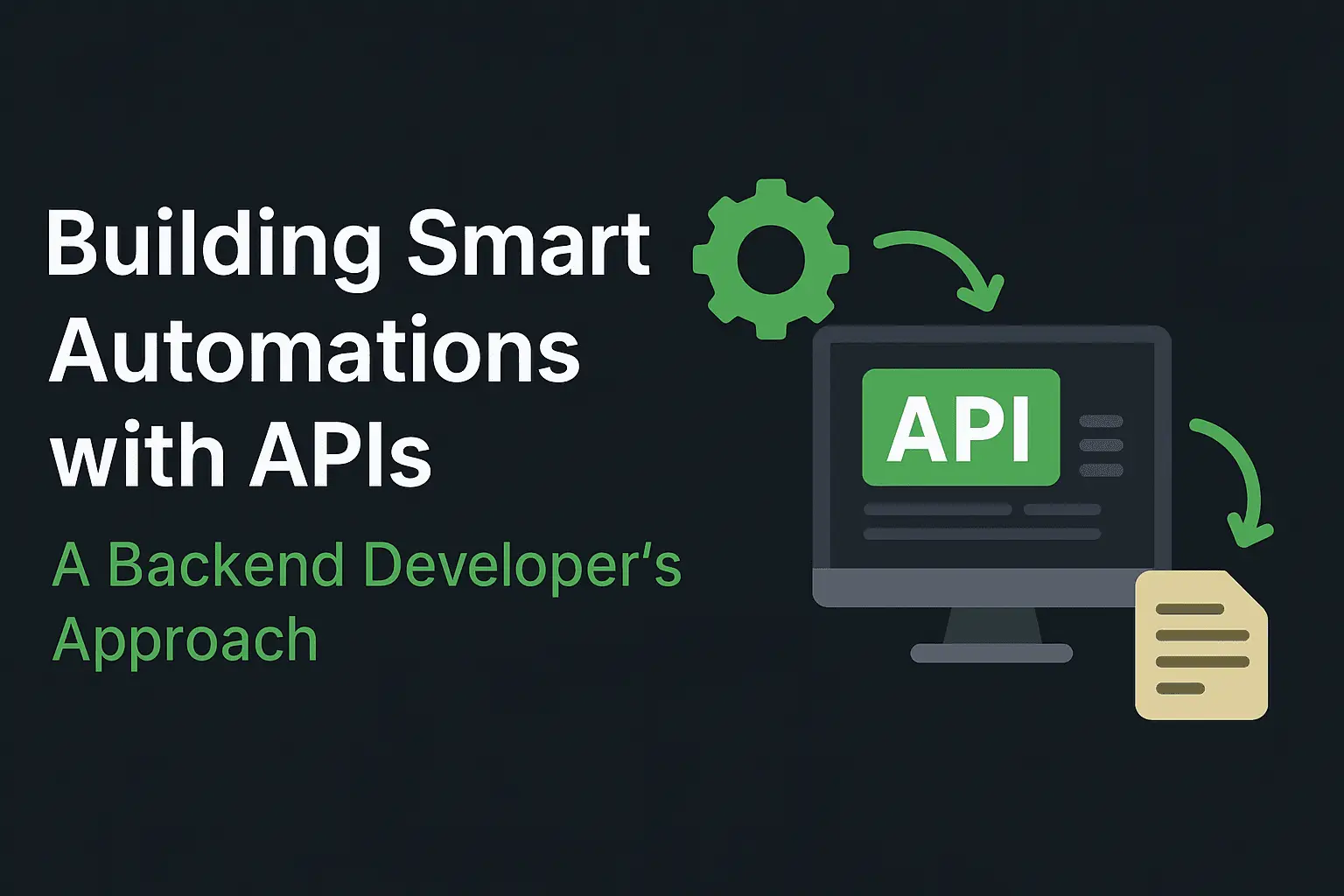Building Smart Automations with APIs — A Backend Developer’s Approach

Building Smart Automations with APIs — A Backend Developer's Approach
Design reliable, secure, and scalable automation systems by combining API-driven architecture, webhooks, queues and robust developer practices.
Smart automations are the backbone of modern digital businesses. As a backend developer, your job is to design systems that reliably translate external events into business actions — without breaking under load, latency, or edge cases. This guide walks through practical patterns, code samples, and operational best practices for building production-ready automations using APIs, webhooks, queues, and observability.
What "Smart Automation" Means
Smart automation goes beyond one-off scripts. It's an architecture that is:
- Event-driven — triggers run when something meaningful happens (order created, lead submitted).
- Reliable — survives retries, idempotency, and network failures.
- Observable — includes logs, metrics, and tracing.
- Secure — authenticates APIs and protects data.
- Scalable — uses queues & workers to handle spikes.
Core Components of API-Driven Automations
- Event Producers: Shopify, payment gateway, form provider, or internal services emitting events.
- Transport: Webhooks or message buses carry events to your backend.
- Ingestion Layer: Validate, authenticate, and persist incoming events quickly.
- Processing Layer: Workers that execute automations (send emails, update CRM, call other APIs).
- Retry & Dead-letter: Retries for transient failures and dead-letter queues for manual handling.
- Observability: Logs, metrics, and distributed traces to measure success and diagnose errors.
Design Pattern: Webhook → Queue → Worker
This pattern decouples external event reception from heavy processing. The webhook acknowledges quickly, then enqueues a job for reliable background processing.
Webhook Handler (Python Flask example)
# app.py (Flask)
from flask import Flask, request, jsonify
import hmac, hashlib
from queue_client import enqueue_job
app = Flask(__name__)
WEBHOOK_SECRET = b'your_shopify_secret'
def verify_signature(payload: bytes, sig_header: str):
expected = hmac.new(WEBHOOK_SECRET, payload, hashlib.sha256).hexdigest()
return hmac.compare_digest(expected, sig_header)
@app.route('/webhook/shopify', methods=['POST'])
def shopify_webhook():
payload = request.get_data()
sig = request.headers.get('X-Shopify-Hmac-Sha256', '')
if not verify_signature(payload, sig):
return jsonify({'error': 'invalid signature'}), 401
event = request.json
# Enqueue a lightweight job for background processing
enqueue_job('shopify_order_created', event)
return jsonify({'status': 'accepted'}), 202Why enqueue? Keeps webhook endpoints fast (low timeout risk) and enables retries, batching, and parallel processing.
Worker (Node.js example)
// worker.js (Node.js + BullMQ)
const { Worker } = require('bullmq');
const axios = require('axios');
const worker = new Worker('shopify-order-queue', async job => {
const order = job.data;
// idempotent operation
await axios.post('https://api.gohighlevel.com/v1/contacts/', {
email: order.email,
firstName: order.customer.first_name,
lastName: order.customer.last_name,
tags: ['Shopify-Customer', 'order']
}, { headers: { Authorization: `Bearer ${process.env.GHL_KEY}` }});
// other processing (send order SMS, notify ops)
}, { connection: { host: 'localhost', port: 6379 }});Key Engineering Principles
Idempotency
APIs and worker logic must be idempotent — the same event processed twice should not create duplicate effects. Techniques:
- Use an external unique event ID (from Shopify or source) as dedupe key.
- Store processed-event IDs in a fast datastore (Redis or DB) with TTL.
- Make API requests include upsert semantics (create-or-update).
Retry Strategy & Backoff
Not all failures are permanent. Implement exponential backoff with jitter for retries. For permanent failures, send to a dead-letter queue for human review.
Rate Limits & Bulk Operations
Respect upstream API rate limits. Batch writes where possible. Example: collect events for 1–2 minutes and perform batched contact upserts to reduce API calls.
Security & Authentication
- Validate webhook signatures (HMAC) and use HTTPS everywhere.
- Use scoped API keys, rotate keys periodically, and store secrets in a vault (e.g., HashiCorp Vault, AWS Secrets Manager).
- Limit outgoing IPs, and apply firewall rules where possible.
Practical Patterns & Recipes
1. Abandoned Cart Recovery
Flow: Shopify cart abandonment webhook → create/update contact in CRM → enqueue delayed job → trigger email/SMS sequence at 10 min, 24 hours, 72 hours.
2. Order-to-CRM Sync
Flow: orders/create webhook → worker upserts contact, tags customer, assigns to pipeline, sends fulfilment notification to Slack/ops.
3. VIP Customer Tagging
Flow: compute LTV weekly using batch job → apply VIP tags → trigger special campaign in GHL for VIP retention.
Code Example: Idempotent Upsert (Python)
def process_order(order):
event_id = order.get('id')
if db.event_exists(event_id):
return
# mark as processed
db.save_event(event_id)
# upsert contact
contact = {
'email': order['email'],
'firstName': order['customer']['first_name'],
}
response = gh_api.upsert_contact(contact) # upsert semanticsObservability: Logging, Metrics & Traces
Instrument your automation pipeline:
- Structured logs (JSON) with correlation IDs to trace a request across webhook → queue → worker → external API.
- Metrics: job success rate, queue depth, average processing time, error rates.
- Tracing: use OpenTelemetry to follow distributed traces for slow requests.
Testing & Local Development
Tools and approaches:
- Use ngrok for local webhook testing.
- Mock external APIs (WireMock, nock) in unit tests.
- Write integration tests that exercise queue processing and failure scenarios.
Scaling Considerations
As your traffic grows, optimize for throughput and reliability:
- Horizontally scale worker pools.
- Use partitioned queues for high-volume event types.
- Consider serverless processors for bursty workloads (AWS Lambda with SQS).
Cost & Operational Efficiency
Balance speed and cost by setting appropriate concurrency, batching, and TTLs. Monitor API usage to avoid unexpected bills and implement budget alerts.
Monitoring Checklist
- Queue depth alerts (thresholds per queue)
- High error rate alerts (>1% job failures)
- Webhook 4xx/5xx ratio
- API rate-limit responses monitoring
Real-World Integration Example: Shopify → GHL
Flow summary:
- Shopify webhook (orders/create) posts to your webhook endpoint.
- Your endpoint validates signature and enqueues job.
- Worker retrieves order, upserts contact to GHL via API, tags it, and triggers a welcome campaign.
- If GHL API returns 429/5xx, worker retries with backoff and logs the event.
// pseudo flow (simplified)
Shopify -> /webhook -> enqueue -> worker -> GHL API -> campaignWant a professional to implement reliable Shopify ←→ GHL automations that scale?
View Pricing & Automation Packages →
